Cancer
Diaries
Part Six:
Mysteries of Science
Written by
Rick Archer
September 2013
Forward
In our previous chapter
on Morris Fishbein, I made little
effort to disguise my shock and contempt for people like Fishbein
who have gone out of their way to suppress natural cures for cancer.
In their desperate attempt to hang onto the existing ineffective and
quite painful chemotherapy-radiation-surgery treatment commonly used
today, millions have died and millions have suffered. Their
motive appears to be greed and money, the so-called root of all evil.
In the process, I have
been accused of maligning the Medical Establishment.
I grow weary of having you repeatedly malign the motives of "the
medical establishment" and the intelligence and the commitment
to the health of their patients of physicians who do not agree
with your point of view.
If I given anyone else a
similar impression, please accept my profound apology. My
Cancer Diaries are hardly an indictment of the entire Medical
Community.
|
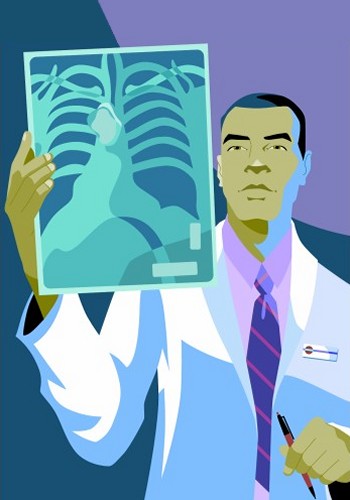 |
| |
|
The Origin
of My Respect for Doctors
|
|
 |
Considering the anger I
have displayed towards Mainstream Medicine, it may come as a
surprise to learn that I have profound respect for doctors and
medical researchers. Yes, I think the medical industry
completely deserves the criticism implicit in these stories.
Yet at the same time, I think doctors are brilliant people.
Maybe that is why I am so disappointed in them. Why they allow
these crooks to dominate them is difficult to comprehend.
The origins of my
respect began in college. As you may know, Johns Hopkins,
my alma mater, is famous for its medical program. That
includes its prestigious Pre-med program for aspiring
physicians. I suppose you would have to be very serious about
medicine to see the beauty in disease.
It is a real advantage
to list a Hopkins degree when applying to medical school. If two
people apply for medical school with similar grades, but there is
only one spot open, a degree from Hopkins will make a big
difference.
During my undergraduate
years at Johns Hopkins, I had the privilege to count numerous
pre-med students as friends. I can testify from personal
experience that every one of them were among the most intelligent,
hard-working students on campus.
|
I can also relate from
personal experience that I was able to observe first-hand the
rigorous gauntlet these young men faced in their search for a career
in medicine.
It is common knowledge
that medical schools take only the best and the brightest.
Since there
are only a limited number of spots available in medical school, with
so many equally talented people vying for one of those precious spots, the
competition for grades at Hopkins was brutal. As always when
the talent is equal, it usually boiled down to who worked the
hardest.
Here again, I had personal experience.
One of my part-time jobs was supervising Hutzler's Reading
Room, a large, cozy study hall. This ultra-quiet room was
designed for study. The lighting was
subdued and the long room was carpeted to keep down the
noise. This room was full of bookcases, comfy
leather chairs and long, smooth study tables made out of
oak. Hutzler's was open all night long. In my
opinion, Hutzlers was more popular for studying than the
Library.
My job gave me the perfect vantage point to observe the
uncanny discipline of the pre-med students. I watched
in quiet respect as they toiled away endlessly in their
attempt to master the material. I had a pet theory all
the Pre-meds congregated in there because misery loves
company.
On the nights before
one of the big exams, the Pre-meds were always the last to
leave. For that matter, some didn't even bother to
leave. They were going to pull what was known as an
"all-nighter". Maybe this would give them the edge to answer that one make-or-break question on the next day's chemistry test.
That question might become the difference between making the A instead of the B on
the All Mighty Curve.
|
 |
Sometimes I
pulled
the graveyard shift.
All night means
ALL NIGHT. The room never closed. Someone had to
supervise. I hated this midnight till 7 am assignment
because I was useless the next day, but someone had to do
it. Fortunately our group was large enough that I only
drew the assignment every two weeks or so. My fellow
workers and I
rotated this unwanted time slot depending on our own
homework and test schedules.
Once in a while,
I would get the graveyard shift on a night when there was a
huge Chemistry test the next day. My elevated chair at
the front desk gave me an eagle's nest to survey
the room. Slowly but
surely the room would thin out until the only ones left were
the Pre-meds. On test night, at 2 am there might be
fifty or more boys scattered across the vast room.
Considering the class size was 200, that meant 1 in 4
students were studying deep into the night. That's
Hopkins for you - 25% of the entire Chem class pulled an
all-nighter. When I say these boys were "serious", I
am not exaggerating.
 |
When they had to rest, they would doze in a
chair or simply lie their heads down on the table. Then
they would wake up and study some more, leaving only when it
came time for the test. That is the kind of sacrifice they
were willing to make to get into medical school. These
young men were dedicated.
You may have
noticed I said 'young men'. The school didn't go coed
till my Senior year. That was they year they let in 9
young ladies.
Considering there were 2,000 male undergraduates, why even
bother? When faced with 1 in 200 odds, this same view
was shared by my entire circle of pre-med friends.
Trust me, I was lonelier than hell throughout college. The
only reason I went to Hopkins was they
gave me a full scholarship. I was very poor. But
most of my Pre-med friends had a wide choice of schools with
actual women. Even though these boys knew full well how lonely they would be for female attention
for four long years, they still chose to come to Hopkins.
That
alone should indicate how much a "Hopkins degree" meant to these
Pre-med students.
|
It is to medical
people
like those After-Midnight Warriors that I extend my apology.
I understand that my Cancer Diaries have given their amazing profession
a black eye. However, now that I have shared the story
of Morris Fishbein, at least
now it should be obvious why I am so angry. Although
Fishbein is gone, I have no doubt that he groomed
someone as equally ruthless to take his place. Judging
from the Burzynski story
in Chapter Three, obviously the baton has been passed on. When I speak of the "Medical Establishment",
that is simply because I have no better name to use for the
amoral cut-throats at the top. Maybe I will call them
the Conspirators from here on out.
For those
medical professionals who resent my use of the term "Medical
Establishment", I hope this clarification helps. I
might add that this does not in any way mean I excuse the
Conspirators responsible for the witch hunts against the alternative
cancer cure practitioners. There is no
doubt in my mind these corrupt individuals exist. If
their presence gives the Medical profession a bad name, then
I have a suggestion. Get rid of them.
That said,
despite the evil at the top, there can be no question that
American medical schools produce some of the finest medical
minds in the world. Perhaps the greatest moment in
American medical history took place in the Fifties.
|
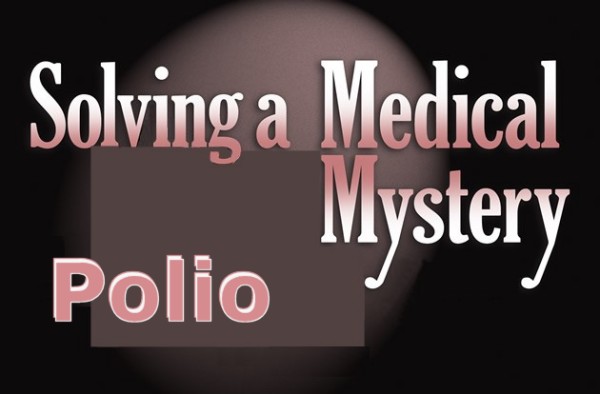 |
The
Scourge That Crossed Our Nation
Earlier I spoke of
my acute loneliness during my college
years at Johns
Hopkins. There were times when I
just couldn't take it anymore. About once a month, I would drive
from Baltimore, Maryland, down to
Northern Virginia for a much-needed break.
My beloved Aunt Lynn and Uncle Dick
knew how much I was struggling. They gave me
permission to come down any time I was desperate for human
warmth.
During the day, Lynn would invariably
sit me down for a pep talk. She would ask how it was
going. Mostly she would offer sympathy and perhaps a
suggestion here and there.
Just knowing this kind woman cared about me made all the
difference in the world.
To this
day, I care for Lynn as if she were my own mother.
|
Uncle Dick was my mother’s
favorite brother.
I was named for him. However,
thanks to Dick Nixon, I preferred to shorten my name to
'Rick'.
Uncle Dick was a very kind man. Over the years, my
uncle became a real hero to me. There was a time when
Uncle Dick actually paid my way to an expensive private
school here in Houston out of his own pocket.
In fact, he did it for two years!
That incredible gesture paid huge dividends. It led to
my full scholarship at that private school which
in turn led to my full
scholarship to college which in turn
led to my full scholarship to
graduate school. Without Uncle Dick’s
generous sacrifice, this
chain of scholarships would never
have been possible.
Small wonder that my Uncle Dick
is a man I admire. I owe much to
Dick and Lynn, two people who were better parents to me than
my own set.
Like Aunt Lynn, Uncle Dick was equally
concerned about me. We would have our conversations
late at night after Lynn and his four children had gone to
bed. We would watch Johnny Carson together till the
wee hours of the morning. This was a special time for
me.
One night
I asked him why he
always limped so badly. Uncle Dick smiled wanly.
“You
wouldn't know this,
Rick, but I was once a very good athlete. Back in high
school, I was captain of my football team. I could
not only walk just fine, I could run
all day. I was a lineman
and pretty good at it. I even tried out for the
Penn State football team, but learned quickly I simply
wasn't big enough to play major college football.
My first clue came when I lined up across Rosie Grier, a
huge man who would go on to be All-Pro for the Rams.
He flattened me like I was a bug.
However I loved the game, so I stuck around. I was accepted onto the Gold team that
scrimmaged with the varsity every day.
I
was still in the Navy when I
contracted polio. It was 1955
and I was stationed in
Maryland near the Chesapeake Bay.
I think I contracted it from
the water at the Patuxent River Naval Station.
One day out of nowhere I noticed I had
a fever. I was staggering and
losing my balance. The next thing I knew, I collapsed.
I could not even walk.
My buddies had to half-carry me to
the clinic. The doctors suspected polio almost
immediately. Then I called Lynn to give her the
bad news. I was scared. Everyone was terrified of
polio. I honestly wondered if I would ever walk
again.
It took
Lynn
about half a day to drive down from Pennsylvania.
When I saw her, Lynn was white as a ghost. The poor woman was paralyzed with fear.
Sure enough, her worst fears were confirmed.
The doctors were now certain I had
polio.
Poor Lynn was in shock.
She knew there was no cure for polio. At first she was
worried that I would be stuck in an iron lung for the
rest of my life. Then she was worried that I would
never walk again. Fortunately
while I was in the hospital my condition did not get
worse.
I was in a lot of pain for a year, but in time
the pain subsided. However, I
still could barely walk. I
could only get around with the
use of crutches. It
would be years before I could walk again without a
crutch.
This was a
pretty bleak time for us. We had an infant son and
I was a cripple. Thank goodness IBM took a chance
on me. Why I will never know. I couldn't
even walk into the room for the interview. I could
not help but notice the interviewer's eyes switched to
my crutches on several occasions.
That
was twenty years ago. My weak leg is
still a real
handicap. Every time I
climb steps I want to scream
in pain. Some
days are better than others
for me, and some days not so
much. Eventually you learn
to live with the suffering.”
The Emergence of Polio
Polio
has been around for a
long time. It has existed quietly
for thousands of years as an endemic pathogen. Polio
emerged in a big way in the 1880s when major epidemics began
to occur in Europe. Like most viruses, it began to
spread. Soon after, widespread epidemics appeared in
the United States.
The first major polio
epidemic in the United States hit Vermont in 1894 with 132
cases. A larger outbreak struck New York City in 1916, with
more than 27,000 cases and 6,000 deaths. As the number of
polio cases grew, the paralytic disease changed the way
Americans looked at public health and disability.
Epidemics became regular
events, primarily in big cities during the summer months.
These polio epidemics left thousands of children and adults
paralyzed. It also killed many of its victims.
No one was even sure where the disease came from. The
fear of catching it became rampant; this provided the
impetus for a "Great Race" towards the development of a
vaccine.
The fight against polio got
under way in 1938. That is when Basil O'Connor founded
the National Foundation for Infantile Paralysis thanks to
the request of our nation’s most famous polio victim.
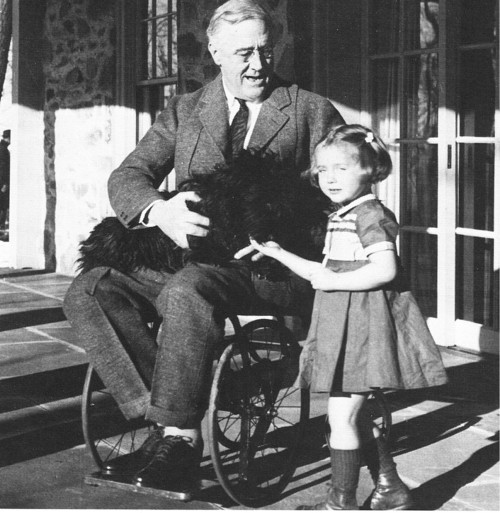 |
And
who might that be?
His name was Franklin Delano
Roosevelt, America’s president.
Basil
O’Connor was a former law partner of President.
One day Roosevelt called O’Connor into his office and asked him if
he would head up this important project. O’Connor
agreed on the spot.
Many people think that
Roosevelt tried to keep his polio a secret. That is
not true. The American public was aware that Roosevelt
had been stricken back in the 1921. What they weren’t
aware of was how serious the problem was.
Indeed, when the world wasn’t looking, Franklin Roosevelt was
an invalid confined to a wheelchair.
Like my uncle who
wondered what message his crutches sent to the interviewer, Roosevelt
was certain the image of that wheelchair
would ruin his chances of election. Roosevelt made sure that no one outside his immediate circle knew that
he was totally crippled.
Roosevelt was 39 years old
when he had been stricken in 1921. However Roosevelt
refused to give up his political ambitions.
And why should he?
Roosevelt might be handicapped, but his mind wasn’t
affected. After a lengthy convalescence, he decided to
run for the governor’s office in New York. However
Roosevelt greatly feared the American public would turn
against him if they knew how badly he was crippled. He
needed their respect, not their pity.
|
So the future governor of
New York and 4-time American President
devised a way to keep his secret
hidden from the world. In private,
FDR spent most of
his time in a wheelchair, but in public, he had his sons
and bodyguards act as secret crutches to give the admiring
crowds the illusion of walking. The
men would walk next to the President and secretly support
him while FDR appeared to be walking under his own power. The deception
worked like a charm. The American Public was
completely fooled. If anything, they admired
FDR even more
for licking the disease which crippled ordinary people.
Personally, I imagine most
people would have admired him just as
much if they knew the
truth. I certainly admired my uncle
for his courage. But that was a chance Roosevelt wasn’t willing
to take.
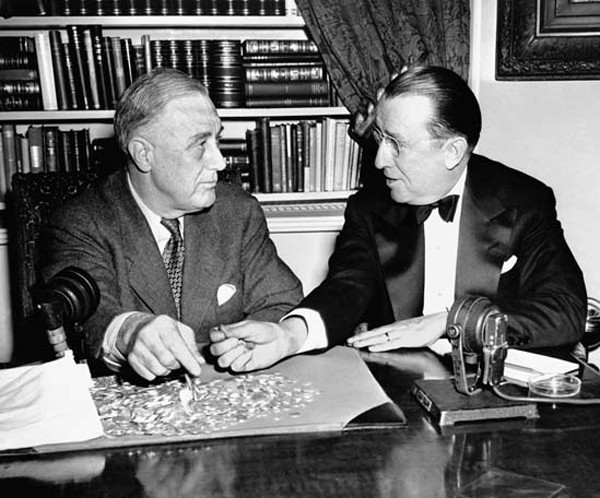 |
March of Dimes
In 1938,
FDR's friend Basil O’Connor helped set
up the first March of Dimes fundraising program. Radio
networks across the land offered free 30-second slots for
promotion. Listeners were asked to send in a dime. The
response was phenomenal. The White House received
2,680,000 letters within days.
Unfortunately, World War II
intervened. It was a real shame,
but the fight against polio had to be put on the
back burner.
However, after the war,
polio returned to the forefront as Public Enemy Number One.
Polio was an especially
cruel disease because it attacked mostly children.
Parents were panic-stricken because no one could figure out
how the disease was being transmitted. Apart from the
atom bomb, America's greatest fear was now polio.
Actually, most people feared Polio
more since the chances of catching it seemed so high.
Polio
was being referred to as the worst plague in American
history. As a result, scientists were in a frantic
race to find a way to prevent or cure the disease.
|
During the war, Jonas Salk
had worked at the University of Michigan developing an influenza
vaccine at the behest of the U.S. Army. After the war
concluded, in 1947, he was appointed director of the Virus
Research Laboratory at the University of Pittsburgh School
of Medicine.
It was in Pittsburgh that
Salk began to put together the techniques that would lead to
his polio vaccine. He was already well aware of the
principle of vaccination. He knew that if the body is
artificially exposed to a harmless form of a disease virus,
the body will produce antibodies that resist or kill the
dangerous form of the virus if later exposed.
Salk was
certainly not the only man who visualized a vaccine as the
solution to the problem. Where Salk differed was his
belief that protective immunity could be induced without
infection by a living virus such as those used in the
vaccines against smallpox and rabies. In developing the
influenza vaccine during the war, he had observed that protection could be
established using noninfectious, inactivated viruses.
In other words, Salk “killed” the virus first, then found a
way to use it anyway.
This was an
important observation. Early attempts to develop a
vaccine ran into numerous hurdles. A vaccine tested on
10,000 children by two researchers at New York University
provided no immunity. Then came the bad news. Because
the researchers were experimenting with highly dangerous
live vaccines, six of the participating children had been
killed. Three others were left permanently crippled.
|
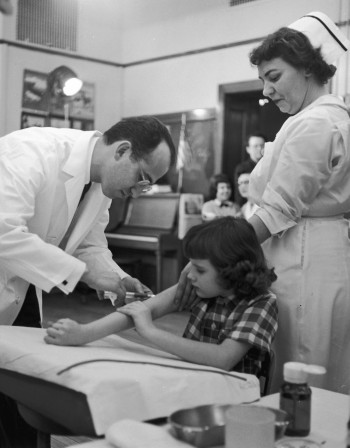 |
After that
horror story, no researcher wanted to go anywhere near other
vaccine trials and no parents dared offer their children up
as guinea pigs. Progress against the disease came to
an alarming halt.
Meanwhile
Salk's research caught the
attention of Basil O'Connor, president of the National
Foundation for Infantile Paralysis. O’Connor was
impressed by Salk’s confident claim that he could create a
SAFE vaccine. On a hunch, O'Connor
decided to bet the farm on this Salk guy.
In 1948, O’Connor convinced
his organization to make Jonas Salk the point man in the
country's efforts to cure polio. They poured huge amounts of
funds into his clinic. Salk assembled a skilled
research team and devoted himself practically non-stop to
this work for the next seven years. He attacked his
project with the zeal of a missionary.
Unfortunately, the cure did
not come overnight. In fact, the problem got even
worse. There was an especially cruel epidemic in 1952.
During the worst
part of the outbreak, hospitals across the nation were filled
with crippled patients housed in iron lungs. The
victims of polio were usually children or very young adults.
Every day the newspapers published heart-rending pictures of
dozens of small children lying helpless as they were kept
alive by these giant metal breathing machines.
The cases dramatically
increased during the summer when children were home from
school. No one could figure out why.
What
could be causing this disease?
The unknown origin of the disease caused great fear. It led
parents to take extraordinary precautions.
Parents kept children home from school, avoided parks and
swimming pools, and allowed their kids to play only in small
groups with the closest of friends.
Furthermore, those friends
had to demonstrate their total health before anyone let them
in the door.
|
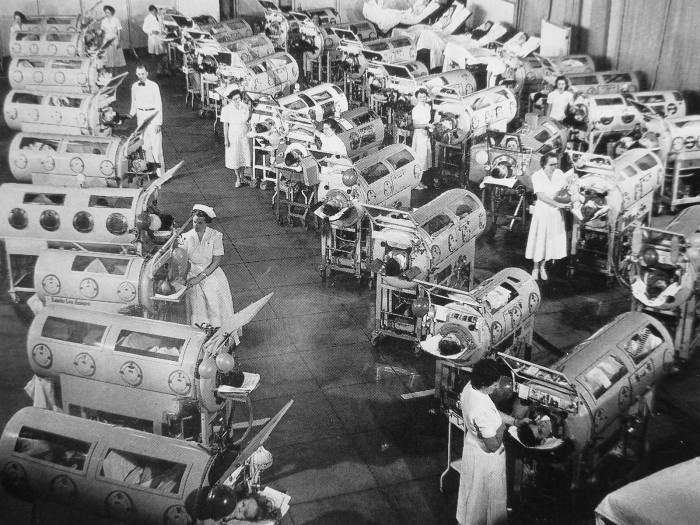 |
As the fear of polio
increased year after year, funds to combat it increased from
$1.8 million in the first year to $67 million by 1955.
Research continued non-stop during those years, but it looked
hopeless. To the dismay of many, everything scientists
believed about polio at first was wrong. Years had
been wasted chasing down many blind alleys. Even
worse, after the test which killed the six children, no one
had the courage to try again.
American historian
William O'Neill wrote:
“This was the situation when
young Jonas Salk entered the picture. No researcher
wanted to become a baby killer. Experiments were put
on hold. Salk succeeded where others had failed
because he decided to use a safer method known as the
‘killed virus’.”
No one really gave Salk’s
idea much hope. How can a virus
that has been 'killed' create
immunization? Despite the general lack of enthusiasm
for this approach, Basil O'Connor backed Salk totally.
After successful tests on
laboratory animals, Salk’s vaccine next had to be tested on
human beings. Now everyone held their breath. On July
2, 1952, assisted by the staff at the D.T. Watson Home for
Crippled Children, Jonas Salk injected 43 children with his
killed virus vaccine.
A few weeks after the Watson tests, Salk injected children
at the Polk State School for the retarded and feeble-minded.
To the relief of everyone, no one died and no one became
paralyzed.
In November 1953, at a
conference in New York's Waldorf-Astoria Hotel, Salk said,
"I will be personally responsible for the safety of the
vaccine."
Salk then announced that his
wife and three sons had been among the first volunteers to
be inoculated with his vaccine. That brave move won
Salk a lot of support. If he was willing to risk his
own family, then maybe he could be trusted. Salk
concluded his talk by saying the time had come to take his
vaccine to the national level. Salk had inspired the
entire country.
Throughout 1954, the scale
of the support for Jonas Salk’s project was both staggering
and exhilarating. It reminded many people of the same
energy that fueled America’s entry into World War II.
Thanks to the hope generated
by Salk’s potential cure, the entire country was galvanized.
In 1954, at least one hundred million people contributed to
the March of Dimes. Seven million donated their time
and labor to put on the March of Dimes. They included
fund-raisers, committee workers, and volunteers at clinics
and record centers.
Now that the money was
there, Salk devised a massive test program. The field
trial set up to test the vaccine developed by Salk and his
research team was the most elaborate program of its kind in
history. It involved 20,000 physicians and public
health officers, 64,000 school personnel, and 220,000
volunteers.
Over 1,800,000 school
children ages six to nine participated in the trial.
Joining America in the test were
children from Canada and Finland.
Known
as “the Polio Pioneers”, half the children received the
vaccine and half received a placebo. Furthermore one-third
of the children who lived in areas where vaccine was not
made available were observed to evaluate the background
level of polio in this age group.
The entire country went “all
in”. Everyone had a stake in the outcome.
Everyone did whatever they could to help.
A 1954 Gallup poll showed
that more Americans knew about the polio field trials than
could give the full name of the US President. According to medical author
Paul Offit,
"more Americans had participated in the funding,
development, and testing of the polio vaccine than had
participated in the nomination and election of the
president."
|
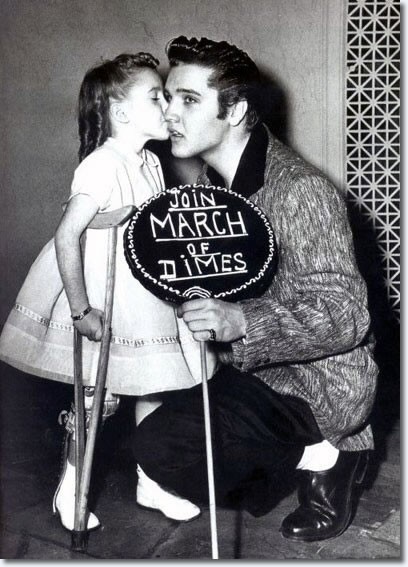 |
On April 12, 1955, the
results of the massive nation-wide test
were ready to be announced. This date had been
selected for a reason. It was exactly 10 years to the
day since the death of President Roosevelt, the man who got
this project started in the first place.
During the test phase, Salk
had asked his mentor Dr. Thomas Francis to be the monitor of
the results. So it was Dr. Francis who took the podium
at the University of Michigan that day.
Five hundred people filled
the room. That total included 150 press, radio, and
television reporters. There were 16 television and
newsreel cameras standing on a long platform at the back.
Across the country, 54,000 physicians were sitting in movie
theaters to watch the broadcast on closed-circuit
television.
The event was also being
broadcast live on radio. Eli Lilly and Company had
paid $250,000 – a monster sum in those days - to broadcast
the event. It was money well spent. Every single
American turned on their radios to hear the details,
department stores set up loudspeakers, and judges suspended
trials so that everyone in the courtroom could hear.
Europeans listened in on the Voice of America. The
entire planet held its breath.
As Francis took the podium,
the room fell to a dead silence. The anticipation and
the tension was practically unbearable. Francis stood
silent for a moment, obviously taking in the amazing drama.
Then Francis smiled.
He declared that the vaccine was not only safe, it was
effective. The room erupted with joy. Everyone
began hugging the nearest person and cried wrenching tears
of happiness.
|
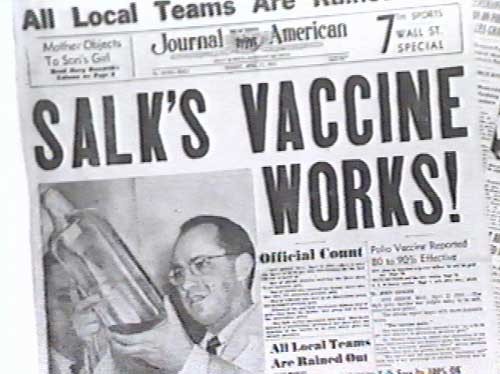 |
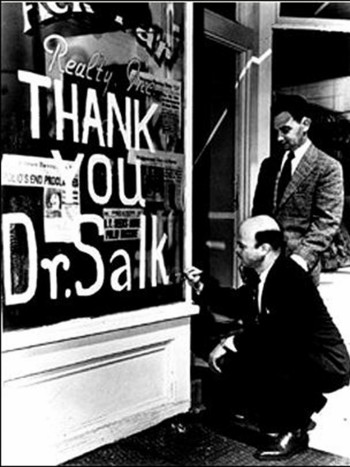 |
Paul Offit writes about the
event:
"The
presentation was numbing, but the results were clear: the
vaccine worked. Inside the auditorium Americans tearfully
and joyfully embraced the results. By the time Thomas
Francis stepped down from the podium, a national celebration
had broken out.
Church bells were ringing across the
country, factories were observing moments of silence,
synagogues and churches were holding prayer meetings, and
parents and teachers were weeping.
One
shopkeeper painted a sign on his window: ‘Thank you, Dr.
Salk’.
'It
was as if a war had ended and the most
bitter enemy defeated,' one observer recalled."
Rick
Archer's Note: As one can see, the results were astounding. In the two years before the
vaccine was widely available, the average number of polio
cases in the U.S. was more than 45,000.
By 1962, that number had
dropped to 910, mostly from children in rural areas that had
no access to vaccination.
n the days that followed, the next step was to immunize the
entire nation. I was one of the millions of kids who
participated. I guess I was about
6 at the time. A sad irony
is that the Salk vaccine was released to the public about
one month after my Uncle
contracted polio.
|
As for Jonas Salk,
he was hailed as a
"miracle worker".
There is one final footnote
to this story.
Jonas Salk had no interest
in personal profit. Salk’s sole focus had been to develop a
safe and effective vaccine as rapidly as possible. His only
wish was to be given the wisdom necessary for the chance to
save America’s children.
When Salk was asked by CBS
newsman Edward R. Murrow who owned the patent to his
vaccine, the scientist replied: "There is no patent.
How could
you patent the sun?"
Jonas
Salk, an American hero.
|
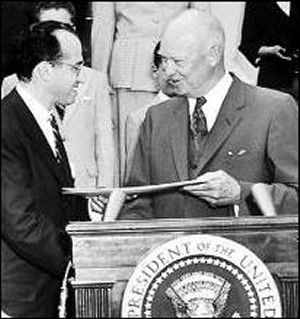 |
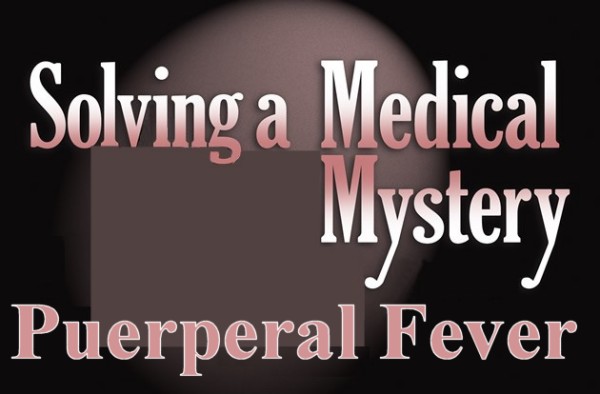 |
Ignaz Semmelweiss
Although
few of us have never heard of Dr. Ignaz Semmelweiss, he
is someone we all owe a great debt to. This is the
man who discovered the importance of washing our hands.
As his reward, he was driven insane.
It is a very
interesting story, so I will share it with you.
But first I would like to share an insight. My
background is in the Social Sciences which means, unfortunately,
that I have little knowledge of medicine.
So when I realized this story dealt with a medical
problem known as Puerperal Fever, my first
instinct was to look it up.
I ran across
a
medical treatise that was 35 pages long and
contained 17,000 words.
|
|
The purpose of the paper was
to trace some of the ideas on puerperal fever which were
published in medical treatises during the period from
1760 to 1850.
After
reading the article for a while, I realize I was
absolutely stunned by its complexity.
It staggers the mind just how much information is out
there. There was no way I could absorb this much
material unless I really put my mind to it. I
decided it wasn't worth my effort.
That is when it
dawned on me that today's doctors have the identical
problem. They are besieged by so much information
that unless it affects them directly, the simplest
coping mechanism is to simply ignore it.
As for me, finally I
gave up. Instead I used the "Find" function to
see if there was anything about Semmelweiss relevant to
my story. I found this one single mention on Page
21:
Towards the end of the period under consideration, a
physician in Hungary produced work that was later to
be regarded as seminal in the understanding of what
is now seen as the infectious nature of puerperal
fever. However at the time, his work was largely
ignored. In 1860 Ignaz Semmelweis published work,
which he had first embarked on about fifteen years
earlier, titled "The etiology, concept and
prophylaxis of childbed fever".
Semmelweiss has not been given prominence in this
present paper, partly because his writing does not
appear to have been given great attention by his own
contemporaries.
Mind you,
this is the man who solved a problem that killed
countless women in his time, but he
rated no more than a mere paragraph in a 35 page masterpiece.
And now, with that less than stirring endorsement of our
main character, let us begin the story of a
much-maligned hero who was driven to insanity.
|
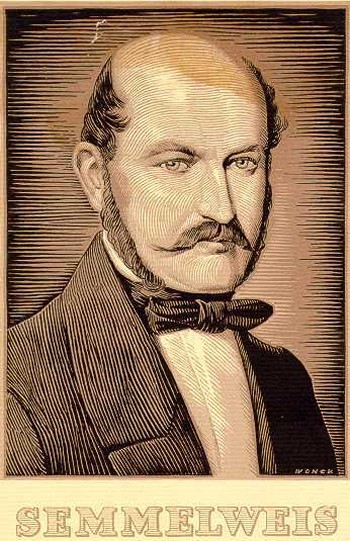 |
Puerperal
Fever in the 1800s
As it turns out, the reason none of us have
ever heard of "puerperal fever" is that it doesn't really
exist any more. Puerperal fever is now rare in the West due to
improved hygiene during delivery. The few infections that do
occur are usually treatable with antibiotics.
However, from the 1600s through the mid to
late 1800s, this disease was the leading
cause of death in child birth. Pregnant
women were terrified of getting "The Fever"
as it was called on the streets of Europe.
It is impossible to discuss health in the
1800s without discussing disease.
Consistent good health was the possession of
only a small percentage of a population.
Lacking a germ theory of disease, people ate
contaminated food, drank contaminated water,
and lived amid animal and human waste
without blinking. Life expectancy in this
era was somewhere between thirty and forty
years.
Lacking knowledge of good nutrition, people
suffered from chronic indigestion, fatigue,
anemia, food poisoning, and other digestive
ailments. The unchecked spread of bacteria,
viruses, and insects resulted in epidemics
of "ague" (aka malaria), cholera, diphtheria,
dysentery, polio, smallpox, and typhoid,
crippling or abbreviating many lives.
Tuberculosis, commonly known as consumption,
was the leading cause of death in the
Nineteenth century. Chronic bouts of
influenza, pneumonia, and other endemic
maladies further reduced not only life's
quantity but its quality. Life was
very grim in those days, especially for
children and mothers. Not only did
half of all children die before their tenth
birthdays, countless women died in
childbirth.
|
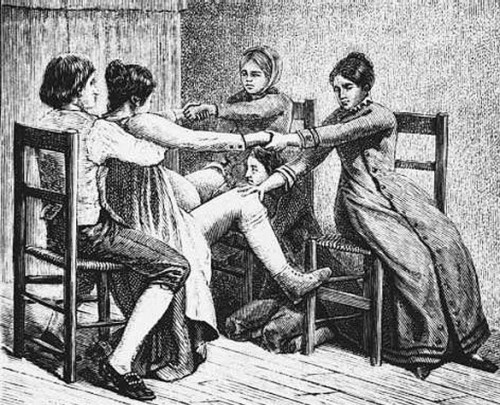 |
Semmelweiss
Dr.
Ignaz Semmelweis was the
chief resident in the First Obstetrical Clinic of the Vienna General
Hospital back in 1846.
His unit saw mostly poor women, many
of whom were prostitutes. Back
in those days, pregnancy was seen by many
women as
a death sentence. It was considered
far safer to end the pregnancy.
To combat this problem, maternity
institutions such as the one in Vienna were
set up across Europe to address the rising
problem of infanticide of illegitimate
children. The clinics
charged no fee and offered to care for the infants.
This made the clinic attractive to underprivileged women. In return
for the free services, the women would be subjects for the training
of doctors and midwives.
|
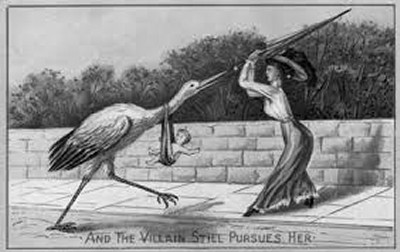 |
Semmelweiss had no
particular interest in Puerperal fever, but he
knew exactly what it was. Puerperal fever was a devastating
disease back in his day. It affected women within the first three
days after childbirth and progressed rapidly, causing acute symptoms
of severe abdominal pain, fever and debility.
Semmelweiss oversaw two
units. In his role as supervisor, Semmelweiss was presented
with a strange problem
right out of the Medical Mystery chapter. The First Clinic of
the hospital had an average maternal mortality
rate due to puerperal fever around 10%. The death rate of
the Second
Clinic was considerably lower, averaging less than 4%.
Unfortunately this
strange disparity
become
known on the streets outside the hospital. The two clinics
admitted on alternate days but due to the bad reputation of the
First Clinic, women begged to be admitted to the Second Clinic.
If they were assigned to the "Death Clinic", some women
were so afraid of dying that they would rather
give birth in the streets. They would have
the baby delivered at home, but would
pretend to have given sudden birth en route to the hospital,
a
practice known as street births. This
meant they would still qualify for the child care benefits without
having to be admitted to the clinic.
|
Semmelweiss was
puzzled
about several things. First, he could not begin to imagine why the
incidence of puerperal fever was so much
higher in one unit than the other.
Second, the problem
was actually worse than just 4% compared to 10%. On certain days,
the "Death Clinic" would mysteriously be visited by a rash of deaths
while on most days there was no difference between Clinic One and
Clinic Two. To Semmelweiss, it was like playing Russian
Roulette. Five out of six days there was no danger at all, but
on the bad days, watch out. Even more troubling, the rate had
risen to 18%.
Another thing
Semmelweiss was puzzled about was
the fact that puerperal fever was rare among women giving
street births.
"To me, it
appeared logical that patients who experienced street births
would become ill at least as frequently as those who delivered
in the clinic. What protected those who delivered outside the
clinic from these destructive unknown endemic influences?"
|
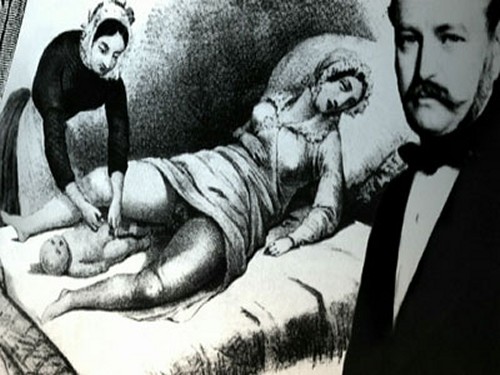 |
Semmelweiss was a sensitive and deeply humanitarian
man.
He was severely
troubled by the higher mortality rate in his First Clinic and took
it personally. In his
words, "these deaths made me so miserable that life seemed worthless."
With his conscience tormenting him day and night, the search for the cause and control of this pitiless disease became
his life's work.
Semmelweiss started a
meticulous process of eliminating all possible differences.
Since the two clinics
used almost the same techniques, the doctor noted the individuals
who worked there were the only major difference.
The First Clinic, aka the
Death Clinic, was the teaching service for medical students. The Second Clinic had been selected in 1841 for the instruction of
midwives only. Try as he could, Semmelweiss could not see how
the more skilled physicians might be contributing to a higher rate
than midwives. If anything, it should be the other way around.
The trained physicians should surely have the safer clinic.
Semmelweiss reviewed the
facts.
- Street births were safer than midwives.
- Midwives were safer than physicians.
Semmelweiss grew more
puzzled by the minute. This made no sense.
A year passed without
Semmelweiss making the slightest bit of headway. He was
growing increasingly frustrated.
Breakthrough
The breakthrough
occurred in 1847 following the tragic death of his good friend Dr. Jakob
Kolletschka.
Recently Kolletschka had been accidentally poked with a
student's scalpel while performing a postmortem examination.
Now it was time for the
medical examiners to see why Kollestschka had died. Kolletschka's own autopsy showed a pathology identical to that of
the women who were dying from puerperal fever.
A series of questions raced through the
doctor's mind. Semmelweiss speculated
that the scalpel that had first cut through
a cadaver had likely caused his friend's
death.
Was there something deadly inside that
cadaver? And what was on that scalpel
that could make a man sick? Although
the naked eye could see no connection, Semmelweiss
imagined there had to be some connection between cadaveric contamination
and puerperal fever. Was it possible that
doctors and medical students working with cadavers could be somehow
giving a disease to the women during delivery?
Noting that students
move between the dissection room and the delivery room without
washing their hands, on a hunch, he set a new policy. From now on,
doctors must wash their hands in a chlorine solution when they left
the cadavers. Maybe the problem was caused by dirty hands.
Semmelweiss had
concluded that he and the medical students carried some sort of
mysterious "cadaverous particles" on their hands from the autopsy
room to the patients they examined in the First Obstetrical Clinic.
This theory would explain why the student midwives in the Second
Clinic, who were not engaged in autopsies and had no contact with
corpses, saw a much lower mortality rate.
One problem - the suggestion of some
sort of unknown "cadaverous material" was a real stretch. The
germ theory of disease had not yet been developed. Semmelweiss
was taking a real chance by suggesting the existence of some danger
that no one could see.
|
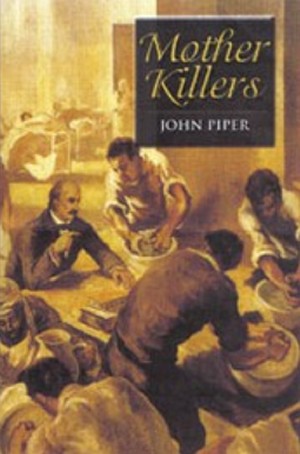 |
|
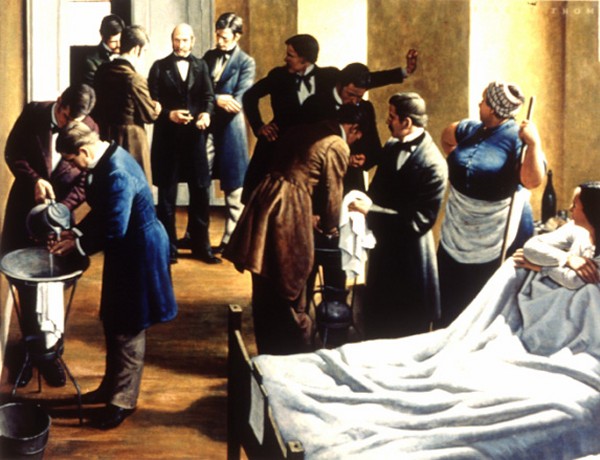 |
On the other hand, it
seemed worth the risk to at least test his theory. He
instituted a policy of using a solution of chlorinated lime, a type
of bleach, for washing hands between autopsy work and the
examination of patients.
Semmelweiss found that
this chlorinated solution worked best to remove the putrid smell of
infected autopsy tissue. He hoped that perhaps destroying the
smell would also kill the contaminating "cadaveric" agent
hypothetically being transmitted by this invisible material.
The results were shocking. The mortality rate in the First
Clinic instantly dropped 90%. It was now comparable to that in the
Second Clinic. The mortality rate in April 1847 was 18.3%.
After two months, the rate was below 2%.
Seeing the instant
results of cleanliness, Semmelweis did not stop with washing hands.
Remembering the deadly scalpel that killed his friend, now he began washing medical instruments as well as hands.
One year later, the death rate in his clinic was down to zero.
It wasn't a miracle... it was the triumph of medical intuition
combined with observation and common sense.
|
The Downfall of Semmelweiss
Imagine curing one of
the most dreaded diseases of the time and being hounded to death for
your trouble. It seems inconceivable, doesn't it?
Women were terrified of this disease. Once a woman contracted
it, the fever was a death sentence. Should not Semmelweiss
have become a hero just like Jonas Salk?
Dr. Ignaz Semmelweiss had essentially eradicated child bed fever
during childbirth simply by advocating for increased hygiene in the
delivery room. One would assume that Semmelweiss would become
a celebrated man. Such was not the case. His life was
now ruined. How can this be?
At first, Semmelweis
said nothing. It was one thing to simply order compliant
medical students to wash their hands. They were used to doing
what they were told and not ask questions.
It was an
entirely different matter to expect a group of eminent,
dignified physicians to suddenly accept some crazy theory of
'cadaverous particles'. Semmelweiss expected that his theories would be met with
skepticism.
At the time, there was quite a lot about disease
that was not understood. There were all sorts of theories
attributing disease to many different and unrelated causes.
With no knowledge of germs, doctors of that day did not
believe hand washing was needed.
"Doctors are gentlemen, and
gentlemen's hands are clean."
Semmelweiss didn't
agree. His hypothesis
was there something on those hands that transferred to the women.
However, he knew his idea that cleanliness was the answer would be considered extreme. He thought it safer to keep his mouth shut.
However, a friend
published two papers on the method. Semmelweiss could hide no
more and now he was ordered to explain himself. The doctors laughed
and jeered. Semmelweiss was largely ignored, rejected or
ridiculed.
|
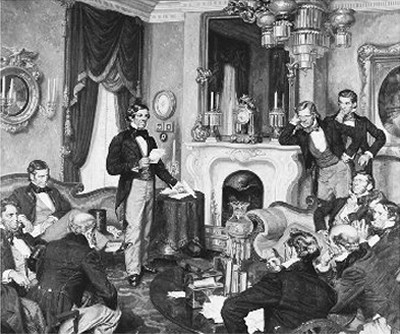 |
The hospital director
had reacted fiercely. Semmelweiss had made a dangerous enemy.
The director felt
his leadership had been criticized. He retaliated by blocking Semmelweiss' promotion. Acting on the director's cue, the
Viennese doctors turned on the Hungarian immigrant.
He was now a stranger in a strange land. Semmelweiss was completely isolated
by a sea of hostility.
After
a year of harassment by the medical community in Vienna, Semmelweiss
was dismissed from the hospital for political reasons. He was
forced to move back to Budapest.
There he brought his
methods to a far more primitive hospital. Semmelweiss went to work.
He cut the death rate by puerperal
fever to less than one percent, but didn't stop there. By
performing autopsies on all victims, he systematically isolated the
various causes of death. He set up control groups and kept careful
statistics on his methods. Finally, in 1861, he wrote a book
on his methods.
The book went nowhere.
Despite overwhelming
theoretical arguments and empirical evidence, Semmelweiss' ideas
were not embraced. Instead, he was treated with scorn and attacked
by his fellow physicians. To the doctors of the mid-19th
Century, the very idea that a gentleman could cause illness because
he was unclean was offensive.
Understandably,
Semmelweiss grew more and more frustrated. How stupid
could these people possibly be? Semmelweiss could not
accept the obstinacy of people who were supposedly dedicated to
healing. He was outraged by the indifference of the medical
profession. Semmelweiss decided to retaliate. He began writing open and increasingly angry
letters to prominent European obstetricians. He grew more and
more polemical, at times denouncing his peers as 'irresponsible
murderers'.
|
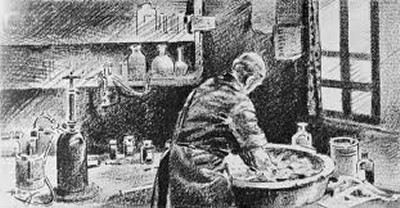 |
Here is a fascinating
example.
Rebuffs to
his struggle for wider application of his doctrine were
disturbing to Semmelweis. He particularly resented attacks by
the self-serving forces of the authoritarian medical
establishment, and he lashed out against them. His doctrine was
opposed by powerful members of the academic hierarchy such as
Professor Kiwisch and Scanzoni of Würzburg. Mortality from
puerperal fever on the services of some of these Professors of
Midwifery ranged as high as a barbarous 26% under Kiwisch at
Würzburg.
The
damning evidence that they were themselves the remorseless
messengers of death was a scarcely veiled threat to their pride
and eminence. Semmelweis was unsparing in his condemnation of
those who denied his doctrine in spite of the high mortality
rates in their own institutions.
This
excerpt come from his open letter to Professor Scanzoni of
Würzburg who, while professor at Vienna, had disparaged
Semmelweis's earliest work:
Your
teaching that the Würzburg epidemic of childbed fever is
caused by unknown atmospheric influences or puerperal miasma
is false. It is based on the dead bodies of lying-in women
slaughtered through ignorance. . . I have formed the
unshakable resolution to put an end to this murderous work
as far as lies in my power so to do. . . If you continue
teaching your students this false doctrine, I denounce you
before God and the world as a murderer, and the History of
Puerperal Fever will not do you an injustice when, for the
service of having been the first to oppose my life-saving
lessons, it perpetuates your name as a Medical Nero.
[
SOURCE ]
Wow... a Medical Nero!
That was quite a tirade.
The years of controversy had turned the man so bitter that he had lost
all patience.
His contemporaries,
including his wife, believed Semmelweiss was losing his mind.
Sadly, they were probably right. The four years since the
publication of his book had turned him into a ranting madman.
In 1865 he was committed to an asylum.
Strangely enough,
fourteen days later he was dead. Although some say Semmelweiss
was beaten to death by the guards, the consensus is that Semmelweiss
either cut his finger or perhaps was wounded during the beatings.
If true, in the dirty asylum, Semmelweiss had fallen victim to the
greatest of ironies.
He had contracted
the same infection that had become his life's work. He had
saved the lives of thousands of mothers only to die from the same
disease that had killed his friend Kolletschka.
Whatever the truth, Semmelweiss
died a broken, pitiful man.
Fortunately, Semmelweiss
did not die in vain. That same year, Joseph Lister began
spraying a carbolic acid solution during surgery to kill germs.
Lister was a friend and protégé of the brilliant French scientist
Louis Pasteur. Once Lister ran across Semmelweiss' manuscripts, he
sensed
immediately that Semmelweiss was right. Lister instituted
practically every suggestion Semmelweiss had made. Soon
puerperal fever ceased being a threat.
In the end, it was
Joseph Lister who gave our unhappy hero his due. Lister said, "Without
Semmelweiss, my achievements would be nothing."
In her book Woman As Healer, Jeanne Achterberg wrote that the
colleagues of Semmelweiss "simply refused to believe that their own
hands were the vehicle for disease." Achterberg continued,
"Instead they attributed the disease to a spontaneous phenomenon arising from the
'combustible' nature of the birthing woman."
Achterberg adds that Semmelweiss was treated
as a heretic, someone little better than a witch at Salem Village.
"Semmelweiss' academic rank was lowered, his hospital
privileges restricted. Despondent, he was committed to an insane
asylum, where he died of blood poisoning, a disease not unlike the
puerperal fever he had almost conquered."
It would be difficult
for one to imagine a more cruel fate.
The progress
of science is strewn, like an ancient desert trail, with the
bleached skeletons of discarded theories which once seemed to
possess eternal life
—
Arthur
Koestler
"Evidence that might cause us to question our beliefs is
used instead to reinforce our beliefs. If long held
beliefs are challenged, we feel a need to defend them.
And as long as we are defensive, our vision will be
cloudy at best. To
remain blind to our beliefs and paradigms, to refuse to
question them, cuts off any real possibility of change."
—
Dr.
Julian Whitaker
|
|
|
| |
|
|
Science
Has Been
Wrong Before
|
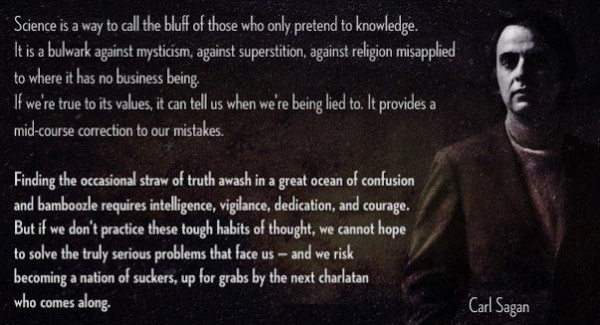 |
I believe science and
medicine offer amazing intellectual
challenges. Yes, unlike the
doctors of the Semmelweiss era, we know all about germs now.
And we know a lot more than that. But I am certain
there are still more invisible things in medicine and
science that we don't know about yet. There is so
much mystery in the Universe. Anyone born with
a sense of curiosity is bound to
be endlessly fascinated by a scientific
or medical career probing for answers.
That includes medicine. Anyone who has ever watched the TV
medical show House knows full well that medicine
holds all kinds of unsolved mysteries to this day.
The story of Semmelweiss is a perfect
example that Science doesn't always get it right. When
confronted with glaring evidence that dirty hands were the
likely culprits in the high mortality rate of the mothers,
the doctors of 1860 behaved like closed-minded bigots.
Talk about dropping the ball!
Today it is so painfully obvious that Semmelweiss was right
that we forget the men who rejected Semmelweiss were the
most educated members of their generation.
Today we laugh. My word, that
happened practically back in the Stone Ages!! How
thick-headed can those cavemen possibly be? We are so
much smarter today.
But let's stop for a second and ask
ourselves this question: Is it possible we can be just as
blind today on certain things as these men were 250 years
ago??
I have no medical training. I
barely know the difference between a peptide and a bacteria.
Who am I to argue that there have been alternative cures for
cancer?
Take a
man like Stanislaw
Burzynski from
Chapter Three. In
my opinion, Burzynski is very close to a breakthrough in
cancer treatment. But that's just my opinion.
I am very well aware that I have no
training and I have no proof. So I decided to ask a
Hopkins-trained medical researcher what he thought about
Burzynski.
Rick's Statement:
"Let Burzynski go about his
business without the constant harassment. If the man is
wrong, then let his failed results speak for themselves.
Like herbal tea and apricot seeds, his cure isn't
'hurting' anyone, so leave him to do his research in
peace. "
Hopkins Cancer Researcher:
"Let me first start by explaining
why I am hesitant about even entering this discussion.
To discuss this with you would be like an astronomer
commenting on an article written by a layman that the
moon is made of cheese. The debate is, frankly, beneath
him/her. And it would be insulting to have his or her
name connected with such a debate.
That is how I and 99% of the
scientific and medical field feel about Burzynski's
current approach to cancer therapy.
(Just as I'm sure 99% of
astronomers feel the moon is not made of cheese, despite
how closely it resembles swiss cheese with its' color
and craters). And don't get me wrong; there are many
spirited debates in biology, in academic and industry
settings, including dozens of countries on what will
bring us closer to the cure.
But these are based on peer
reviewed, independently verified data. Data
collected by testing with preclinical models (i.e.
tissue culture cells, mice, ...), and then clinical
trials in humans, measuring safety and efficacy.
Burzynski has none of this bolstering his "cure".
And your conspiracy angle is
ludicrous considering the number of people and
governments that would have to be involved.
At the risk of being insulting,
Rick, you don't know, what you don't know."
I think that sums it up pretty well. This
comment made by a conventional cancer researcher is typical
of the attitude of Mainstream Medicine towards Burzynski.
As
it stands, the majority of today's medical community
denounce Burzynski to be little
better than a fraud.
To even begin to give Burzynski the benefit of the doubt is
beneath contempt.
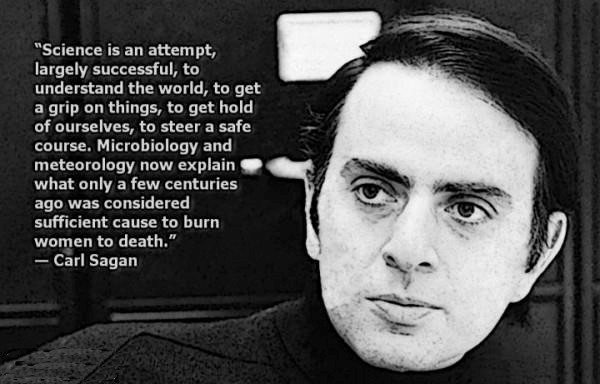 |
This man seriously doubts the
possibility that Burzynski is on the right track. His
mind is made up.
Let me
say this man has a point. For me to be right
that Burzynski's cure for cancer has real
potential, countless
members of modern medicine
who know a hell of a lot more about
medicine than I do would have to be taking the wrong
approach.
For example, it seems ludicrous that
people would bet on a philosophy major like me over a man
with a doctorate in Cellular and Developmental Biology.
Is it
even possible that he could be wrong?
Although
it seems
far-fetched that a highly-trained cancer
researcher could be wrong about Burzynski, I contend it is not
out completely out of the realm of possibility.
Over the
centuries there have been some beliefs that were real
whoppers.
History is filled
with examples of
long-held beliefs that defy all credulity.
Let's
take a fun stroll down memory lane.
|
At the risk of upsetting the Creationists,
scientists agree the Earth is a bit older than the 6,000
years as suggested in the Bible.
Current estimates, based on
radioactive dating, place the age of the planet at around 4.5
BILLION years. Hmm,
those biblical scholars may have been a bit off.
Once upon a time, the Bible was
considered a scientific work. People took it for granted
the Bible was
accurate even when it didn't always make much sense.
The age of our planet
is a good example.
Back in the 17th century, a
religious scholar named Archbishop Ussher took a hard look at the
Bible. He estimated that creation
took place in 4004 BC.
Bishop Ussher’s specific chronology
dating the creation to 4004 BC became the most accepted and popular
timeline, mainly because this specific date was attached to the King
James Bible. Add in nearly 2,000 more years
since the birth of Christ to get to the 18th
century and you get about 6,000 years.
The
church made sure that number came into wide acceptance.
|
 |
What is interesting is the
number of people
today who still
take the 6,000 year
Bible estimate seriously.
Our good friend Wikipedia,
an aspiring modern day Bible in its own right, has something
to say about the controversy.
Wikipedia cites a 2006
Gallup poll saying 43% of Americans believe that "God
created human beings pretty much in their present form at
one time within the last 10,000 years or so."
The Poll adds that the
percentage of believers decreases as the level of education
increases.
Don't ask me who is right. When
I stop and think about it, I don't have any training
whatsoever to contradict the Bible or the scientists.
We have reach a point in civilization where we are all
deeply dependent on science and technology, yet hardly any
of us can even begin to understand how all this stuff works.
And that includes the methods science uses to date the
Earth.
 |
Unfortunately, we are all dependent on the work of others. I
don't have any way to know how old the Earth is. So who
is right and who is wrong? Good question. It all boils
down to whom you choose to believe. While I have been trained to
accept the word of Science, other people have been trained to
accept the word of their religious leaders.
Same
thing with cancer research. Most of us have been trained to
accept the word of modern medicine. Mr. Skeptical prefers the
word of alternative medicine. Mr. Research prefers the word of
conventional medicine. As for me, I read the arguments
from both sides of the aisle and see they both make good points.
I conclude from the
cancer research disagreement
that there are a lot of things about the Universe we don’t know much
about. That is what makes the search for "The
Truth" so interesting.
When it comes to mystery, Science and
Medicine are the two best Games in town. However, both
Science and Medicine
have a long history of chasing up blind alleys. Isn't it a
shame that
God doesn't ring a little bell whenever we are on
the right track?
|
For example,
I seem to remember some guy named Copernicus who suggested the Sun,
rather than the Earth, was at the center of the galaxy. This
happened around 1543. Copernicus then had the
good sense to die immediately of old age rather than face a
firestorm of protest.
The unlucky fate of being one of the first people to agree with
Copernicus fell to Giordano
Bruno, an Italian philosopher and
scientist. Throughout his life Bruno
championed the Copernican system of astronomy which placed the sun,
not the Earth, at the center of the solar
system. He opposed the stultifying
authority of the Church and refused to recant his philosophical
beliefs throughout his eight years of imprisonment by the Venetian
and Roman Inquisitions. Finally the Church had
enough of his rebellion and sentenced him to death.
At
this, Bruno famously replied, "Perhaps you pronounce this sentence
with greater fear than I receive it."
It takes a brave man to
die for his beliefs!
On
February 16, 1600, the Roman Catholic Church executed Bruno for the
crime of heresy. He was taken from his cell in the early hours of
the morning to the Piazza dei Fiori in Rome and burnt alive at the
stake. To the
very end, Church authorities were fearful of the ideas of a
man who was known throughout Europe as a bold and brilliant thinker.
In a peculiar twist to the gruesome
affair, the executioners were ordered to tie his tongue so that he
would be unable to address those gathered.
Upon the death of
Bruno, Galileo
stepped forward to defend the Copernican
system. Bad move. Now it
fell upon Galileo to take the heat. Galileo was tried by the Holy
Inquisition
in 1633.
Galileo was found "vehemently suspect of heresy" and forced
to recant his ideas under threat of torture. Galileo,
now an elderly man too weak to resist, gave in. The
foremost scientist of his day spent the rest of his life
under house arrest.
|
 |
Can you imagine the
stupidity of it all?
The man they call "the Father of modern physics" and "the Father of
modern science" was locked away for the rest of his life.
Over
the centuries religious intolerance has led to other appalling
mistakes. One need look no further than the Spanish
Inquisition or the Salem Witch Trials to know this.
Men never do
evil so completely and cheerfully as when they do it from
religious conviction.
– Blaise Pascal
The story of the Sun controversy is the most
dramatic, but there are
plenty of other stories where
long-held beliefs were laid to rest with great
difficulty.
Another well-known example was
the widely-held theory that the Earth was flat.
Thanks to a guy named
Columbus and a few other brave sea explorers, that notion
disappeared around the end of the 15th century. The common myth was
that the world was flat. If so, then Columbus was indeed the bravest
of the brave for risking his life by challenging that view.
Give him credit for that.
However, most scholars agree that Columbus was pretty sure the Earth
was round.
|
 |
Unfortunately, modern research
now suggests that Columbus in nowhere near the
greatest explorer in history, but rather the
luckiest. There is
increasing evidence he was rewarded for being
stupid. Columbus simply made the most
brilliant blunder in history.
A spherical Earth
had been the general opinion of Ancient Greek
science. This view continued through the Middle Ages
among the educated. As early as the sixth
century B.C., the Greek mathematician Pythagoras
surmised the world was round, and two centuries
later Aristotle backed him up with astronomical
observations. By 1492 most educated people knew the
planet was not shaped like a pancake.
What stopped all other
explorers from trying the Western route was not the
threat of sea monsters or falling off the cliff at
the edge of the world, but rather a good grasp of
Mathematics.
|
Since their calculations said the
western route was an enormous distance, why bother? In
their opinion, the Moon might actually be closer than India
if they sailed to the west.
The game of the day was to find a sea
route to India, the land of riches. At this point in
time, the two choices were a land route through Egypt that
would someday become the Suez Canal or a lengthy sea trip
around South Africa. Both routes were painfully slow.
But to assume that going west would
produce a faster route was unthinkable!
Where Columbus differed from the
generally accepted view of his time was his (incorrect)
belief in a significantly smaller diameter for the Earth.
Columbus claimed that Asia could be easily reached by
sailing west across the Atlantic. Of course, he may have
just said that to get the job. Those costly exploring gigs
were hard to get.
For nearly a decade, Columbus lobbied
European monarchies to bankroll his quest to discover a
western sea route to Asia. In Portugal, England and France,
the response was always the same: no. And why
not?
The scholars in the day of Columbus
made calculations that pegged India as being three to four
times FURTHER to the west than to the east. A quick
look at Google Earth confirms that fact. India is
about 5,000 miles east from Portugal as the airplane flies,
but almost 20,000 miles taking the western route of
Columbus. Based on their own calculations, the
scholars dismissed Columbus's claim that the Earth was much
smaller as nonsense.
Consequently these same experts told
the monarchs of these countries that his
calculations were wrong and that the voyage would
take much longer than he thought.
Oddly enough, the royal advisors in Spain raised
similar concerns to King Ferdinand and Queen
Isabella. However, they had just gotten rid of the
Moors and were feeling lucky.
It turned out the naysayers
were right. Columbus had dramatically underestimated
the earth’s circumference and the size of the
oceans. But, luckily for him, he ran into the
uncharted Americas. We all know what happened from there.
Columbus has gone down in history as one of our greatest men.
Only recently has modern thinking suggested Columbus' discovery of the New
World was not due to skill, but rather his ignorance.
The New World had been discovered not by the greatest
explorer of the day, but by the most
incompetent one. Columbus was literally the only sailor
dumb enough to try this route. Sometimes it is better
to be lucky than good.
|
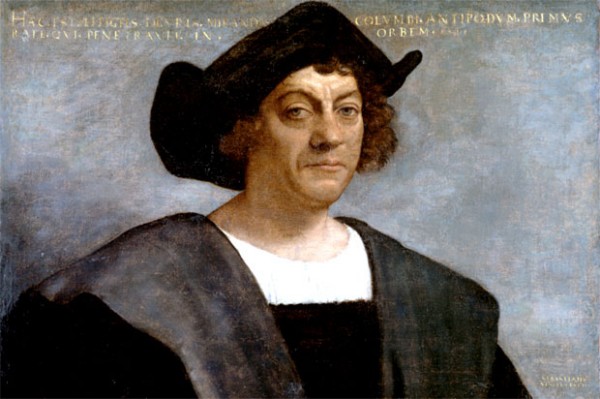 |
Sometimes incompetence is useful. It helps you keep an
open mind.
-
Roberto Cavalli
Compounding his mistake, Columbus was
so stupid that when he landed in the Bahamas, he was certain he
had found the outskirts of India!
Columbus wasn't sure what to make of his discovery. Columbus
was just barely smart enough to discern he wasn't in India, but he stuck to his guns and
assumed he was at least close to India. Columbus
concluded he had arrived in a scattering of islands just to
the east of India. Therefore Columbus decided to name this
chain of islands "The West Indies". All natives
of the West Indies were to be referred to as "Indians".
This mistake has doomed every person in America to call our
North American indigenous people "Indians" ever since.
Thanks to Columbus and his goofy math skills, everyone from
Gandhi to Geronimo are commonly
referred to as "Indians".
Believe it or not, to the end of his life in 1506, Columbus
still maintained that he had reached Asia.
Medical Follies
Columbus, unfortunately, is not the
only fool in history. He is simply the most famous
one.
These kind of follies are not limited
to astronomy, science and exploration.
The history of
Medicine is
also lined with mistakes and crazy theories.
Over the centuries, archaic concepts such as alchemy,
bloodletting, phlogiston and phrenology were once popular,
then eventually discarded. But these were just the side
shows. They were nothing compared to some of the major
medical boo-boos along the way.
For example, back in ancient
Greece, the so-called birthplace of modern medicine, doctors
like the second-century Greek physician Galen believed that
the liver (not the heart) circulated blood while the heart
circulated some sort of mystical serum known as "vital
spirit”.
It wasn't until 1628 that
English physician William Harvey let everyone in on the big
secret. He wrote a book with a catchy title - "An
Anatomical Study of the Motion of the Heart and of the Blood
in Animals". It took a while to gain acceptance, but
eventually the medical community got it right… the heart
pumps the blood, not the liver. Hard to believe,
right?
Today we take DNA for
granted as the building block of all living organisms, but
it wasn’t always that way. DNA was discovered in 1869,
but for a long time it went unappreciated. In the eyes
of the medical community, DNA was an afterthought.
Although DNA was doing all the work, no one figured that
out. DNA was always overshadowed by its flashier protein
counterparts in the minds of the researchers. Those
proteins surely held the ultimate secret to life.
Even after experiments in
the middle part of the 20th century offered proof that DNA
was indeed the genetic material, many scientists held firmly
that proteins, not DNA, were the key to heredity. DNA, they
thought, was just too simple to carry so much information.
It wasn't until Watson and
Crick published their all-important double-helical model of
DNA’s structure in 1953 that biologists finally started to
understand how such a simple molecule could do so much.
Hmm. Here’s another one.
What about germs? We take that discovery for granted too.
However, as we read in the Semmelweiss account,
even as recent as the late 19th century the
doctors didn't really see the need to wash their hands before
picking up a scalpel.
The result was a lot of gangrene.
Most early-19th century doctors tended to attribute contagion to
"bad air" and other causes. Meanwhile countless injuries
during the Civil War that should not have been life-threatening
resulted in death.
Stonewall Jackson was a notable
example. In 1863 Jackson was accidentally
shot by his own man, a sentry who lost his cool. Jackson was hit by
three bullets, two in the left arm and one in the right hand.
However, none of the wounds were considered serious.
However, sure enough, the left arm developed gangrene and had to be
amputated. His death soon followed.
Meanwhile Semmelweiss died in the insane asylum in 1865. He
had gone mad because no one would listen to him.
|
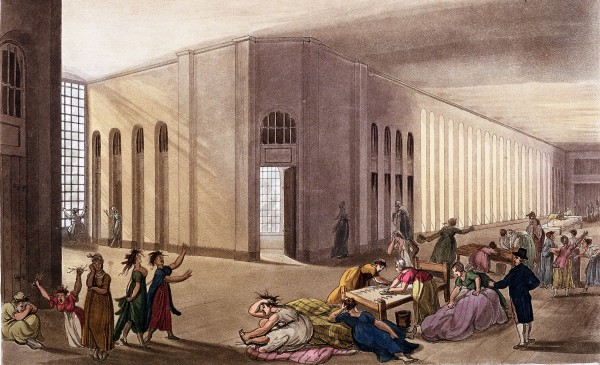 |
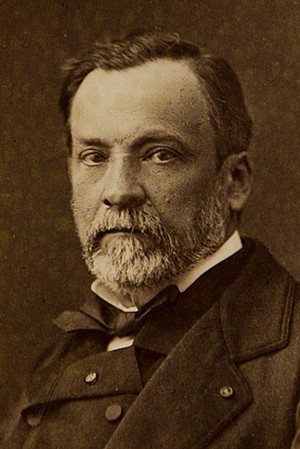 |
As it turned out, over in France Louis Pasteur was
working on the same issues as Semmelweiss. In
1856, Pasteur received a visit from a man called
Bigo who worked at a factory that made alcohol from
sugar beet. Bigo’s problem was that many of his vats
of fermented beer were turning sour. Much of
the beer had gone bad and had to be thrown away.
From a business point of view, this was a disaster.
Bigo asked Pasteur to find out why his beer kept
spoiling.
After using a microscope to analyze samples from the
vats, Pasteur found thousands of tiny
micro-organisms. He became convinced that they were
responsible for the beer going sour. Pasteur
believed that these organisms were the CAUSE of the
putrefaction of the beer, not the result as others
claimed.
Pasteur continued his work on this theme by studying
other liquids such as milk, wine and vinegar. In
1857, he was appointed Director of Scientific
Studies at the Ecôle Normale in Paris. Between 1857
and 1859, Pasteur became convinced that the liquids
he had studied were being contaminated with microbes
that floated in the air.
The
medical establishment ridiculed him:
"I am afraid that the experiments you quote,
M. Pasteur, will turn against you. The world
into which you wish to take us is really too
fantastic." -
La Presse, 1860
Pasteur
was vilified in public. However, rather than give up, he
was
determined to fight for what he believed in. Pasteur
started to devise tests to prove that he was right.
|
In April 1864,
Pasteur explained his beliefs in front of a gathering of
famous scientists at the University of Paris. He proved his
case beyond doubt – even if some of those present refused to
believe him. The eminent doctor Charlton Bastian stood
up and maintained his belief that putrefaction came from
within and not from invading micro-organisms.
The entire Victorian Era was filled
with controversy. First Semmelweiss, then Pasteur, then
Lister were met with open opposition for their heretical
ideas that unseen germs were causing wide-spread damage.
Fortunately not everyone was
close-minded. Once
Louis Pasteur explained his
theory of germs in the 1860s, certain
people started listening. It took a while, but doctors like
Joseph Lister realized that hospitals and doctors had the
potential to pass on life-threatening germs to patients.
Building
on Pasteur's work, Lister pioneered the idea of
actually cleaning wounds and using disinfectant. Then he
suggested doctors might think about washing their hands.
Of course now Lister came
under attack. Lister had been invited to leave
Edinburgh and join the prestigious King’s College Hospital
in London. The newspapers reported Lister as saying that it
was his duty to go to King’s because the teaching of surgery
in London was very bad.
Such publicity did not go down well
with his future London colleagues.
"Who is this ignorant
professor from an insignificant Scottish University," they
said, "that he should dare to criticize the great London
teaching-schools?"
|
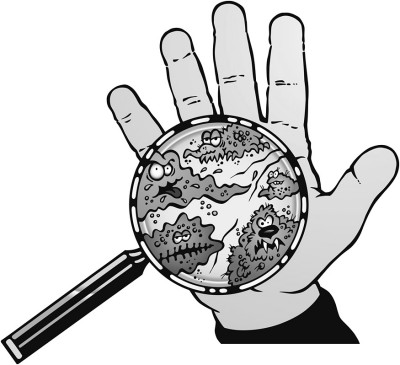 |
It was left to Pasteur to finally get
it through their thick skulls that germs were the problem.
According to Dr. Emile Roux, one of
Pasteur's assistants, the actual cause of the puerperal fever was
not revealed until 11 March 1879. On that day Pasteur was
attending the Academy of Medicine in Paris and the subject
of the disease came under discussion.
One of
(Pasteur's) most weighty colleagues was eloquently
enlarging upon the causes of epidemics in lying-in
hospitals; Pasteur stood up and interrupted him from his
place.
"None
of these things cause the epidemic; it is the
nursing and medical staff who carry the microbe from
an infected woman to a healthy one."
And as the
orator replied that he feared that the microbe would
never be found, Pasteur went to the blackboard and drew
a diagram of the chain-like organism (the
streptococcus), saying:
"There, that is what it looks like!"
Pasteur's
conviction was so deep that he could not help expressing
it forcibly. It would be impossible now to picture the
state of surprise and stupefaction into which he would
send the students and doctors in attendance. With
an assurance and simplicity almost disconcerting in a
man who was entering a lying-in ward for the first time,
he criticized the hospital's appliances and declared
that all the linen should be put into a sterilizing
stove. No one said another word in opposition.
[
source ]
Thus ended the agonizing search for
the cause and prevention of puerperal fever. Vive le Pasteur!
Stories like these make you
wonder. One hundred years from now, what will people
say about today’s methods for
cancer treatment? Will people laugh and say today’s
“modern” approach to cancer treatment was the equivalent of
putting the Earth in the center of the Universe?
In my opinion, today's conventional
approach to the cure of cancer isn't working very well.
When Patrick Swayze and Steve Jobs have access to the best
cures of modern medicine and get nowhere, it is pretty hard
to have much confidence in conventional treatment.
So who is right? Who
has the right approach to the Holy Grail of a cure for
cancer? Is it Burzynski or is it
the Medical Establishment?
Ask yourself who you would put your
money on... or better yet, your life. When you get
cancer, it becomes your life you are betting on.
An old error is always more popular
than a new truth.
—
German
Proverb
All truth passes through three stages.
First, it is ridiculed. Second, it is
violently opposed. Third, it is accepted as
being self-evident.
—
Arthur
Schopenhauer
|
|
|
|
|
The Story of Smallpox
|
Smallpox was once the most feared disease in the world.
An
estimated 300 million people died from smallpox in the 20th century
alone. This virulent disease is so powerful it kills one in every
three people it infects.
Smallpox was particularly catastrophic in virgin populations. The
Spanish inadvertently owe much of their success in conquering the
Aztecs and Incas in Mexico in the 16th century to smallpox.
Unlike the Spanish, the native Indians had no immunity to the
disease, having never encountered it before.
A
century later the North American Indians suffered a similar
devastation. In the 18th century, smallpox decimated the aborigines
when it reached Australia, the last corner of the world to have
escaped its ravages.
Just to see a picture of
someone with smallpox is enough to scare the wits out of anyone.
Even today no cure for smallpox exists.
Fortunately we have little to worry about because smallpox is
currently eliminated from the planet.
However, our government has decided to keep a small stockpile of
smallpox "just in case". Just in case for what?
|
 |
|
 |
It was the discovery of vaccination
that solved the problem of
smallpox. This took place in 1800. Today
vaccination is
something we all take completely for
granted, but
not many people know the remarkable story behind its
discovery.
We owe the discovery of
vaccines to an Englishman named
Edward Jenner. Jenner is the man who gave us our first
vaccine. In so doing, he
conquered Smallpox,
one of the deadliest diseases in history.
Jenner is often called "the
Father of Immunology". Jenner is said
to have "saved more lives than any other man in history".
Edward Anthony Jenner (1749
– 1823) was an English physician and scientist from
Berkeley, Gloucestershire. In
Jenner’s day, smallpox was just as deadly as cancer is
today. Voltaire, the French philosopher, estimated
that in his time 60% of the population caught smallpox and
20% of the population died of it. There seemed to be
no solution
to this terrible disease.
Fortunately, Jenner happened
to be in the right place at the right time. Like so
many other discoveries, Jenner combined the work of others
before him with his own insight. He had access to
three different pieces of the puzzle.
For starters, the concept of
inoculation was already in existence. However, it
carried serious risks. In fact, a person was just as
likely to die from a smallpox inoculation as he or she was
to catch the disease from the environment. So there
wasn’t much value in even bothering.
Jenner was also aware that
several physicians had recently noted that anyone who had
previously contracted a far less dangerous disease known as
Cowpox seemed to have a mysterious immunity to Smallpox.
|
Cowpox was a disease similar to smallpox, but much less
virulent. In fact, it was rumored to be a blessing to
catch Cowpox, but no one knew a direct step to get so lucky
other than hang out with cows all day.
Found in Jenner's records was the notation that Jenner heard from a
dairymaid, “I shall never have smallpox for I have had cowpox. I
shall never have an ugly pockmarked face.”
That proved to be the
inspiration for Jenner. Pondering this, Jenner
concluded that cowpox not only protected against smallpox but
perhaps it
could be transmitted from one person to another as a deliberate
mechanism of protection.
In May 1796, Edward Jenner found a young dairymaid, Sarah
Nelms, who had fresh cowpox lesions on her hands and arms.
|
 |
|
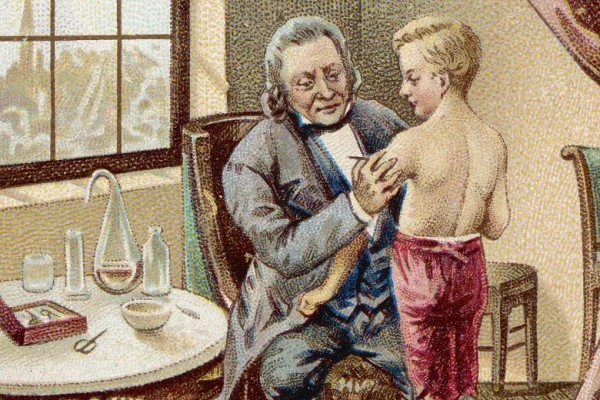
|
On May 14,
1796, using matter from Nelms' lesions, he inoculated James Phipps,
the 8-year-old son of his gardener.
Jenner
knew it was very dangerous to use a human as his guinea pig, but he
figured the worst thing that would happen would be the boy might
develop cowpox... not the dreaded smallpox.
Now
Jenner sat back and observed. Subsequently, the boy developed mild fever and
discomfort. Then 9 days after the procedure he felt cold and lost
his appetite. Everyone held their breath.
Fortunately, the next day, James felt much better.
Now
came the test of fire. In July 1796, Jenner inoculated the boy again, this time
with matter from a fresh smallpox lesion. No disease developed, and
Jenner concluded that protection was complete.
Emboldened by his success with the boy,
Jenner widened his sample. Jenner vaccinated
over 23 volunteers – mostly
children – with the same cowpox
material. .
|
This took some real guts.
What if the injection got them sick? The volunteers all
knew they were taking a huge chance. They
too were the equivalent of guinea
pigs.
Sure enough, practically every subject immediately ran a
fever. Every parent was full of apprehension.
Fortunately, they all breathed easier when the fevers
quickly subsided.
Now
Jenner took an even bigger risk. He deliberately
exposed the children to smallpox. The vaccine worked!
Not one of the subjects got sick.
It was
now 1796. After Jenner successfully
tested his hypothesis on the 23
subjects, it was time to report his findings to the Royal Society.
But he didn’t get very far. Edward Jenner faced great
skepticism when he announced his discovery of vaccination.
To his consternation, the Royal Society refused to even
publish the initial paper.
Jenner was incredulous. He had
clear proof that his vaccine protected people from the most
dangerous disease on earth and all these learned doctors did
was yawn.
Undeterred, Jenner went back and did more tests and
took down more statistics. Then he resubmitted his
paper. The medical establishment,
ever cautious, deliberated at length over his findings.
A great argument ensued.
|
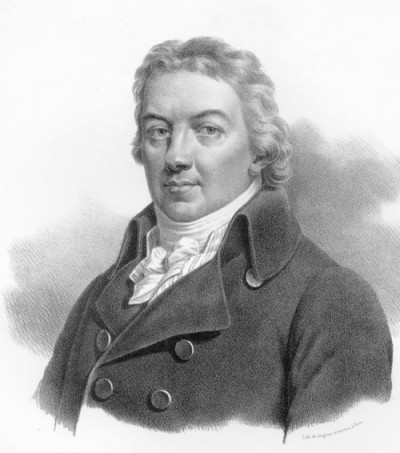 |
During the time that the physicians
deliberated, Jenner was widely ridiculed.
Some of Jenner's fiercest critics
were the clergy. Sermons
proclaimed that it was
repulsive and ungodly to inoculate someone with material
from a diseased animal (cowpox).
Some objectors believed that the
vaccine was “unchristian” because it came from
a lowly animal.
There was great fear involved too. What
were the consequences of receiving material
originating from cows? Would people
begin to develop cow features themselves? Would they
get sick with something besides smallpox?
Of course we laugh today, but take
into account the fear of the unknown can be quite crippling.
Let us not forget the children who died from the polio
vaccine that didn't work in our story about polio.
Meanwhile Jenner waited. 1797. One year
passed. More debate.
1798. Two years passed. More debate. Whispers came to him
about the many surgeons who did not want Jenner to succeed. These
men were the
variolators whose large incomes were threatened by
Jenner's safer and more effective cowpox treatment.
Variolation was a risky precursor to vaccination. If
it worked, great, but 2% of the people died from the
procedure itself. In addition, the mild form of the
disease which the patient contracted could spread, causing
an epidemic. Victims of variolation could be found at
all levels of society; King George III lost a son to the
procedure as did many others.
Another years
passed. 1799. Finally in 1800 the Royal Society
decided to test
Jenner's ideas out on their own.
When they got similar results, the wait was over.
Jenner was proven correct. Meanwhile
four long years had passed waiting for implementation of
this life-saving vaccine.
Vaccination proved to be one
of the greatest medical breakthroughs of all time. In
time, Jenner’s discovery of vaccination has made it possible
to greatly reduce some of the world’s deadliest epidemics
and diseases, from cholera and measles to the bubonic
plague.
All truth passes through three stages.
First, it is ridiculed. Second, it is
violently opposed. Third, it is accepted as
being self-evident.
—
Arthur
Schopenhauer
|
|
Doctor Oz
|
"Is the most
trusted doctor in America doing more harm than good?"
In
Chapter Three of my
Cancer Diaries, I said that it was the support of Burzynski
by Dr. Oz that finally convinced me to watch Part I of the two
Burzynski documentaries.
What I didn't say is
that I spent an hour investigating Dr. Oz first. I found a 9
page article about Dr. Oz in the February 2013
New Yorker Magazine written by Michael Spector.
Spector suggested that Mehmet Oz might be hurting Americans.
So what exactly is Dr.
Oz doing to hurt America?
Spector took Oz to task for being too open-minded with his TV show by giving
dangerous credence to so-called fringe medicine... like Burzynski,
for example.
Here is an interesting
excerpt from page 7 and 8 of Spector's New Yorker article:
|
 |
 |
Mehmet Oz refers to the
academic world as a “fortress,” and he is determined to tear
down its walls.
In the past, his
enthusiasms, even when unsupported by data, have usually
fulfilled the Hippocratic oath to do no harm. Lately,
however, he seems to have moved more firmly into the realm of
tenuous treatments for serious conditions.
On one recent
episode, “Dr. Oz’s 13 Miracles for 2013,” he included “a
revolutionary new way to live years longer: it’s red palm oil.”
He went on, “Its red color is perfect, because I think of it as
a stop sign for aging.”
I asked Oz several times why he promotes
that kind of product, and allows psychics, homeopaths, cancer
theorists and purveyors of improbable diet plans and dietary
supplements to appear on the show.
Oz replied that he takes his
role as a medium between medicine and the people seriously, and
he feels that such programs offer his audience a broader
perspective on health.
|
“Ultimately,
if we want to fix American medicine we will need
skeptical and smart patients to dominate. They
will need to ask the hard questions, because much of
medicine is just plain old logic. So I am out there trying
to persuade people to be those patients."
And, to Oz, that often
means telling his viewers what the Medical Establishment doesn’t want
them to hear: that their answers are not the only answers,
and their medicine is not the only medicine.”
But, when he tells
his audience, with no credible evidence, that red palm oil may
reduce the risk of Alzheimer’s disease, is he empowering people?
Or is he encouraging them to endanger their health with
another “miracle”?
Addressing such
issues, however, is part of what Oz describes as “the
un-discussed conversation—the one we need to have but don’t.”
He
describes modern medicine as a “civil war”
waged between conventional physicians and those who are open to
alternative cures
for maladies ranging from anxiety to cancer; he considers it his
mission to walk the line that divides them.
But more often
his show seems to erase that line completely, with results
that may be less benign than Oz and his many viewers
realize.
“I
want no more barriers between patient and medicine. I
would take us all back a thousand years, when our
ancestors lived in small villages and there was always a
healer in that village—and his job wasn’t to give you
heart surgery or medication but to help find a place for
safe conversation.”
|
 |
There are many legitimate and articulate opponents of
conventional medicine. But Oz has consistently chosen guests
with dubious authority to argue those positions. Joseph Mercola,
an osteopath, runs mercola.com, one of the most popular
alternative-health Web sites in the country.
Oz has described Mercola as a “pioneer in holistic treatments,”
and as a man “your doctor doesn’t want you to listen to.” ....
When Oz says that Mercola is “challenging everything you think
you know about traditional medicine and prescription drugs,”
it’s hard to argue. “I’m usually earnestly honest and modest
about what I think we’ve accomplished,” Oz told me when we
discussed his choice of guests. “If I don’t have Mercola on my
show, I have thrown away the biggest opportunity that I have
been given.”
I had no idea what he meant. How was it Oz’s “biggest
opportunity” to introduce a guest who explicitly rejects the
tenets of science?
“The fact that I am a respected professor—one of the youngest
professors ever—at Columbia, and that I earned my stripes
writing hundreds of papers in peer-reviewed journals,” Oz began.
“I know the system. I’ve been on those panels. I’m one of those
guys who could talk about Mercola and not lose everybody. And so
if I don’t talk to him I have abdicated my responsibility,
because the currency that I deal in is trust, and it is trust
that has been given to me by Oprah and by Columbia University,
and by an audience that has watched over six hundred shows.”
I was still puzzled. “Either data works or it doesn’t,” I said.
“Science is supposed to answer, or at least address, those
questions. Surely you don’t think that all information is
created equal?”
Oz sighed. “Medicine is a very religious experience. I have my religion and you have yours. It becomes difficult for
us to agree on what we think works, since so much of it is in
the eye of the beholder. Data is rarely clean.”
All facts come with a point of view. But his spin on it—that one
can simply choose those which make sense, rather than data that
happen to be true—was chilling.
“You find the arguments that support your
data,” Oz said,
“and then it’s my fact versus your fact.”
Read More
So what is my point?
The impression I got from the New Yorker article is that Dr.
Oz would be considered "overly open-minded" by his peers. Oz made it
clear that he doesn't think science is nearly as precise as it pretends to
be. Even today, there is still a lot of guess-work involved in what
works, what doesn't, and the reasons "why" and "why not".
Dr. Oz reserves the right to have his own views on medicine based on
his experience, instincts, and personal insight. Just like religion,
Oz contends so much about medicine is unknown that some of his ideas
are based on a type of faith, or 'intuition' if you prefer.
Dr. Oz says his professional excellence has given him the right to
state his own opinions even when they fly in the face of
conventional wisdom. In other words, just because the data isn't
there to prove something works doesn't mean it doesn't bear further
investigation.
Dr. Oz said that he was one of the few guys in medicine who could
talk openly about controversial figures like Burzynski with
impunity.
Interesting statement.
After I read
what Oz had said, I decided
to watch the Burzynski documentary. "Okay," I said to myself, "If
Dr. Oz is willing to put his reputation on the line for this Burzynski
guy,
that is good enough for me."
I like Dr. Oz. I
also like Dr. Sanjay Gupta of CNN. Both men have an honesty
about them I find reassuring. I sense that these men will tell
me what I need to know regardless of the professional consequences.
|
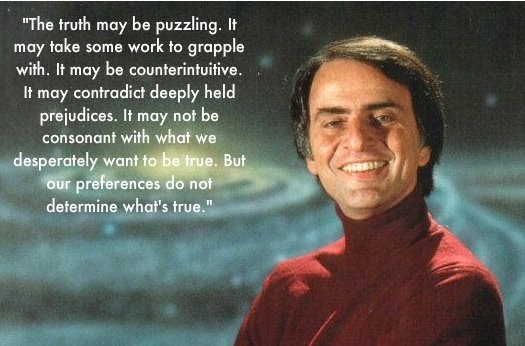 |
|
| |
The Man Who Cured
Ulcers and Stomach Cancer
|
It is very easy to
laugh at the complete ignorance of the Victorian Era medical
community that turned a blind eye to Ignaz Semmelweiss,
Louis Pasteur, Edward Jenner, and Joseph Lister. While
countless victims died, the doctors of the day turned their
backs on these brilliant medical innovators.
History always has the
last laugh. We now know what a bunch of close-minded
idiots those opposing doctors were back in the old days.
The evidence was right before their eyes and they ignored it
to save their pride, their dignity, and their pocketbooks.
Then they did the same thing with Smallpox and germ theory.
The danger is that we assume that our modern Medical Community
would NEVER be so ignorant. No doctor would make the
same mistake today.
Oh really? From what I gather, most
doctors are pretty sure of themselves these days. Check out
this Semmelweiss quote.
|
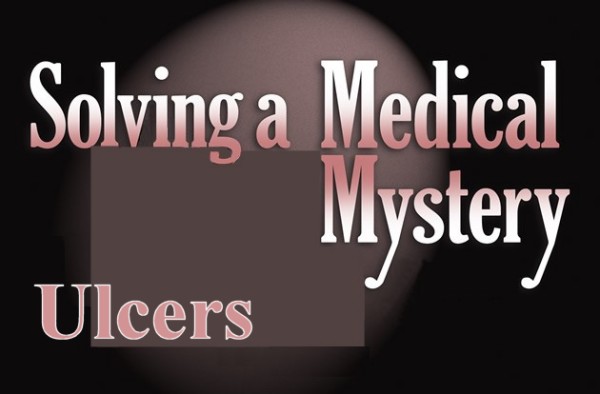 |
In keeping with our purpose, this account of the
contributions of Semmelweiss to the control of puerperal fever will
serve as a reminder of the state of the art in their
time.
It will also call attention to
the striking contrast
between the slowness with which medical advances
were accepted in the mid 1800's and the readiness
with which new concepts and technologies are adopted in
the present day. [
source ]
Please keep that
quote in mind as you read the following story.
|
Barry Marshall
is the 2005 Nobel Prize winner for Physiology and Medicine.
That said, I wager that unless you are in the medical field,
you have never heard of Dr. Barry Marshall.
Marshall is the
man who discovered that ulcers are caused by a bacteria.
Not only that, he also discovered that ulcers are easily
cured by antibiotics.
Furthermore,
Marshall discovered that people who develop stomach cancer
always have an ulcer problem first. Now that Marshall
has found a way to cure ulcers
easily, stomach cancer has virtually disappeared.
How amazing is that?
Only one
problem. By daring to challenge long-standing medical
beliefs, Marshall was met with tremendous rejection.
Barry Marshall
seems to be the modern day equivalent of Dr. Semmelweiss.
No, he didn't go insane. What he did do was take an
amazing gamble in order to get people's attention.
|
 |
It is difficult to get a man to understand something
when his income depends on his not understanding it .
– Upton Sinclair
|
The
Story of Barry Marshall
Barry Marshall
had just made an amazing discovery. He had found not
only the cause for ulcers, but he knew how to cure them as
well.
However,
Marshall got nowhere. He couldn't get published, he
couldn't get anyone to listen to him, he couldn't get
funding, and he was constantly ridiculed and disrespected.
Mainstream
gastroenterologists were dismissive, holding on to the old
idea that ulcers were caused by stress.
They were positive that ulcers were the unfortunate psychosomatic consequence
caused by the heavy stress
of modern life.
Marshall knew better.
These people were all wrong.
So why did
Marshall think his ideas were so vigorously opposed?
He concluded his solution was going to cost a lot of wealthy
people a lot of money.
Let's examine this Interview
from Discover Magazine.
|
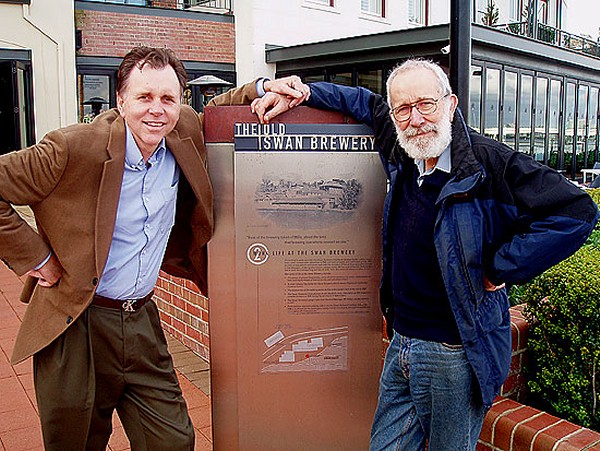
Barry Marshall and Robin Warren, 2005 Nobel Winners
for Medicine |
[
Note: These excerpts are drawn from the
March 2010
issue of
Discover Magazine written by Pamela Weintraub ]
Weintraub: How
did you come to rethink
the cause of ulcers?
Marshall:
Before the 20th century, the ulcer
was not a respectable disease. Doctors would say,
“You’re under a lot of stress.” Nineteenth-century
Europe and America had all these crazy health spas and
quack treatments. By the 1880s doctors had developed
surgery for ulcers, in which they cut off the bottom of
the stomach and reconnected the intestine. We’re pretty
certain now that by the start of the 20th century, 100
percent of mankind was infected with Helicobacter
pylori, but you can go through your whole life and
never have any symptoms.
Weintraub:
How did
you get the word out about your discovery?
Marshall:
I presented that work at
the annual meeting of the Royal Australasian College of
Physicians in Perth. That was my first experience of
people being totally skeptical. To gastroenterologists,
the concept of a germ causing ulcers was like saying
that the Earth is flat. After that I realized my paper
was going to have difficulty being accepted. You think,
“It’s science; it’s got to be accepted.” But it’s not an
absolute given. The idea was too weird.
Weintraub:
Then you and your
research partner Robin Warren wrote letters to The
Lancet.
Marshall:
Robin’s letter described
the bacteria and the fact that they were quite common in
people. My letter described the history of these
bacteria over the past 100 years. We both knew that we
were standing at the edge of a fantastic discovery. At
the bottom of my letter I said the bacteria were
candidates for the cause of ulcers and stomach cancer.
Weintraub:
That letter must have
provoked an uproar.
Marshall:
It didn’t. In fact, our
letters were so weird that they almost didn’t get
published. By then I was working at a hospital in
Fremantle, biopsying every patient who came through the
door. I was getting all these patients and couldn’t keep
tabs on them, so I tapped all the drug companies to
request research funding for a computer. They all wrote
back saying how difficult times were and they didn’t
have any research money. But they were making a billion
dollars a year for the antacid drug Zantac and another
billion for Tagamet.
You could
make a patient feel better by removing the acid.
Treated, most patients didn’t die from their ulcer and
didn’t need surgery, so it was worth $100 a month per
patient, a hell of a lot of money in those days. In
America in the 1980s, 2 to 4 percent of the population
had Tagamet tablets in their pocket. There was simply
no incentive to find a cure.
Weintraub:
So how
did you finally convince the medical community?
Marshall:
I didn’t understand it at
the time, but Procter & Gamble [the maker of
Pepto-Bismol] was the largest client of Hill & Knowlton,
the public relations company. After I came to work in
the States, publicity would come out. Stories had titles
like “Guinea-Pig Doctor Experiments on Self and Cures
Ulcer,” and Reader’s Digest and the National Enquirer
covered it. Our credibility might have dropped a bit,
but interest in our work built.
Whenever
someone said, “Oh, Dr. Marshall, it’s not proven,” I’d
say: “Well, there’s a lot at stake here. People are
dying from peptic ulcers. We need to accelerate the
process.”
And
ultimately, the NIH and FDA did that. They fast-tracked
a lot of this knowledge into the United States and said
to the journals: “We can’t wait for you guys to conduct
these wonderful, perfect studies. We’re going to move
forward and get the news out.” That happened quite
quickly in the end. Between 1993 and 1996, the whole
country changed color.
Weintraub:
Even now,
though, isn’t it hard for new ideas to be heard when
medical journals are gatekeepers of the status quo?
Marshall:
It’s true, but they have their ears pricked up now
because every time a paper comes to them, they say:
“Hang on a minute, I had better make sure that this is
not another Barry Marshall paper. I don’t want to have
my name on that rejection letter he shows in his
lectures.”
Now instead
they might hesitate for a second, then say, “It’s so
off-the-wall....but is it true?”
[
Source ]
Dr.
Jekyll
In 1981 Barry Marshall began
working with Robin Warren, the Royal Perth Hospital pathologist.
Two years earlier, Warren had discovered the gut could be overrun by
a hardy, corkscrew-shaped bacteria called Helicobacter pylori.
Working
together, Marshall and Warren realized that the bacterium
Helicobacter pylori (H. pylori) is the cause of
most peptic ulcers.
As you have read,
Marshall's work was met with incredible skepticism. Mainstream
gastroenterologists were dismissive, holding on to the old idea that
ulcers were caused by stress. If Marshall was right, this
would reverse decades of medical doctrine holding that ulcers were
caused by stress, spicy foods, and too much acid.
Biopsying ulcer patients
and culturing the organisms in the lab, Marshall traced not just
ulcers but also stomach cancer to this gut infection. The cure, he
realized, was readily available: antibiotics.
Now Marshall had
to test his theory, but no one would cooperate and no one
would listen to him.
Unable to get anyone to
sanction his test, Marshall watched in horror as ulcer
patients fell so ill that many had their stomachs
removed or bled until they died. But
Marshall's hands were tied. Unless he was willing to break the
law, there was nothing he could do about it.
Marshall was unable to make his case in studies with lab mice
because Helicobacter pylori affects only primates.
Marshall was likewise
prohibited from experimenting on people without permission from
medical authorities. Gone were the days when Edward Jenner
could give his gardener's son cowpox as a medical experiment.
If Marshall tried that today, he would lose his license.
Watching his patients
continue to suffer and die, Marshall grew desperate.
So Marshall devised a
remarkable strategy to get people's attention.
He decided to run
an experiment on the only human patient he could ethically recruit:
himself.
That's right... Marshall offered himself up as a
guinea pig.
|
Marshall drew
some Helicobacter pylori from the gut of one of his ailing patients.
Then he stirred it into a broth and drank it. Now he waited.
As the days passed, he developed gastritis, the precursor to an
ulcer. Then he started vomiting. Then his breath began
to stink. He felt sick and exhausted.
Back in the lab, Marshall biopsied his own gut, culturing H. pylori.
Despite how sick he was, Marshall smiled.
His unbelievable stunt had worked. Marshall had
actually infected himself with an
ulcer... thereby proving his point what REALLY CAUSED ULCERS.
Marshall now had all the evidence he needed to show that bacteria were
indeed the underlying cause of ulcers.
But he was also a very sick
man. Now what? The standard treatment at the time for an
ulcer was
surgery to remove the diseased part of the stomach.
Would
Marshall be forced to undergo surgery? Actually, no.
Marshall had the foresight to work out his cure in advance.
|
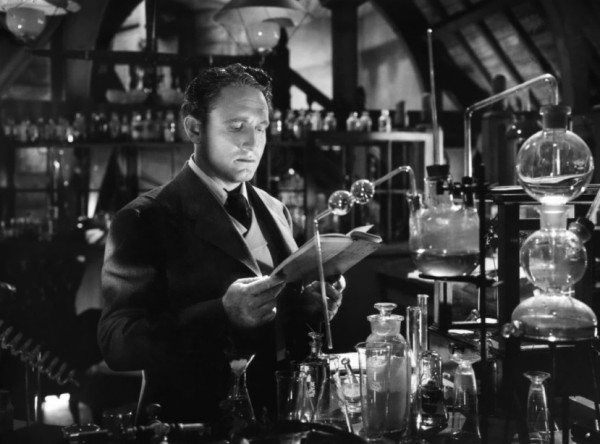 |
Weintraub:
What led up to
your most famous and most dangerous experiment, testing your
theory on yourself?
Marshall:
I had a patient with gastritis. I
got the bacteria and cultured them, then worked out which
antibiotics could kill his infection in the lab—in this case,
bismuth plus metronidazole. I treated the patient and did an
endoscopy to make sure his infection was gone.
After that I
swizzled the organisms around in a cloudy broth and drank it the
next morning. My stomach gurgled, and after five days I started
waking up in the morning saying, “Oh, I don’t feel good,” and
I’d run in the bathroom and vomit.
Once I got it off my stomach,
I would be good enough to go to work, although I was feeling
tired and not sleeping so well. After 10 days I had an endoscopy
that showed the bacteria were everywhere. There was all this
inflammation, and gastritis had developed.
I wasn't really
worried. After all, I had already tested my own culture
with antibiotics ahead of time. I knew I could lick this
thing.
That’s when I told
my wife.
Weintraub:
Are you serious? Do you
mean she didn't know? How did she react?
Marshall:
I should have recorded her
response. Of course she screamed. Then she said
something completely unintelligible, but I knew the meaning was
that I had to stop the experiment STAT and take some antibiotics.
My wife was paranoid
that she would catch it and the kids would catch it and chaos —
we’d all have ulcers and cancer.
So I said, “Just
give me till the weekend.”
She said, “Fair
enough.”
Weintraub:
You published a
synthesis of this work in The Medical Journal of Australia in
1985. Then did people change their thinking?
Marshall:
No. My work
just sat there as a hypothesis for another 10 years. Some
patients heard about it, but gastroenterologists still would not
treat them with antibiotics. Instead, they would focus on the
possible complications of antibiotics.
By 1985 I could cure
just about everybody, and patients were coming to see me in
secret—for instance, airline pilots who didn’t want to let
anyone know that they had an ulcer.
Weintraub:
When did you
realize H. pylori caused stomach cancer, too?
Marshall:
We observed that everybody who got stomach cancer developed it
on a background of gastritis, an irritation or inflammation of
the stomach lining.
Whenever we found a person without
Helicobacter, we couldn’t find gastritis, either. So as far as
we knew, the only important cause of gastritis was Helicobacter.
Therefore, it had to be the most important cause of stomach
cancer as well.
Marshall's discovery allowed for a breakthrough in understanding a
causative link between Helicobacter pylori infection
and stomach cancer.
Marshall realized that
the only people developing stomach cancer had to develop a gastric
ulcer first. By curing ulcers with antibiotics, stomach cancer
had no place to take hold. So in a sense Marshall had cured
this scourge as well.
Fourteen years!
It took
Marshall four years to get published in 1985 and then TEN MORE years to finally get the Medical Community
at large to listen to
him.
In the end, Marshall had to poison himself just to get
their attention.
It was Semmelweiss
all over again.
|
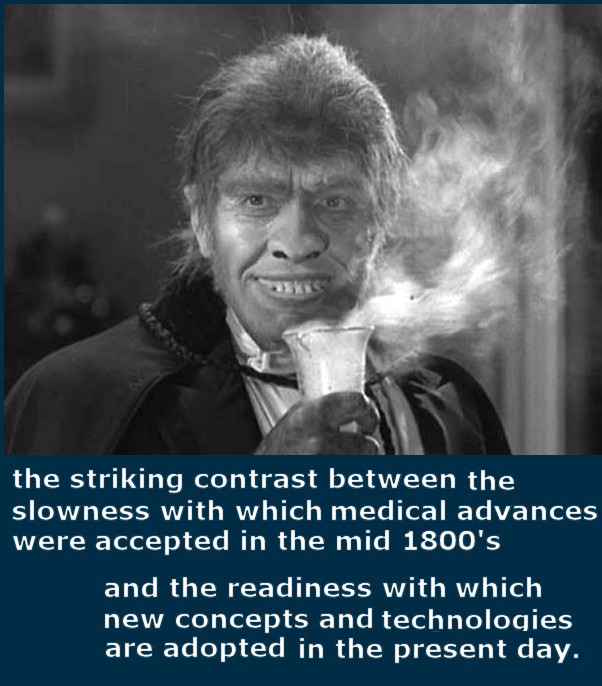 |
All truth passes through three stages.
First, it is ridiculed. Second, it is
violently opposed. Third, it is accepted as
being self-evident.
—
Arthur
Schopenhauer
|
|
|
|